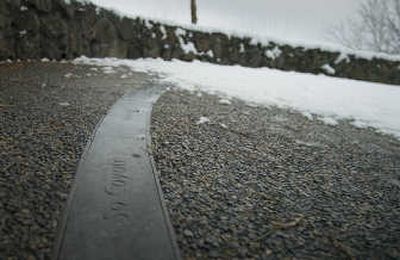Spiral of Alexie poem a visual monument

Most monuments and landmarks stand tall before us, some as big as a house or, somehow, prominent and easily noticeable. A very special one in Spokane is actually under foot, as if it’s intended to be part of the earth on which the city stands.
It’s a poem by former Spokane resident and prolific American Indian author, poet, playwright, comedian, lecturer and just about anything else he wants to be – Sherman Alexie. His poem, “That Place Where Ghosts of Salmon Jump,” was the final piece of public art installed in conjunction with the construction of the downtown Spokane Public Library in 1995.
The entire poem, which was published in Alexie’s 1996 book of poetry “The Summer of Black Widows,” is inscribed in a spiral fashion in polished granite tiles on a concrete 595-square-foot platform in the library’s Overlook Park at the south end of the Monroe Street Bridge and in view of the Spokane Falls. It is surrounded by a low traditional rock wall, as if being nurtured in a protective bird’s nest.
Karen Mobley of the Spokane Arts Commission said it’s a piece of visual art intended to honor the written word, certainly fitting for a library. And it is part of the Spokane Sculpture Walk tour (a brochure is available at several locations around town or at the Web site: www.spokanearts.org/Sculpture_Walk_
Brochure.pdf.
Alexie, who now lives in Seattle, recalls being approached to do a poem as an art installation for the new library. “I wasn’t so well known then,” he said, “so the idea of having me do it was a risky move, risky to put the work of a relatively unknown artist in such a permanent location, risky to put the work of a Spokane Indian there.”
When he first walked over to the site (he lived in Spokane from 1991 to 1994), it was just a broken-down sidewalk, he recalls. “The river was the center of our lives, the center of our religion, so that location, there overlooking the river, is just where I wanted the poem to be. I looked down at the river and its beauty and also wondered how many inches of mercury lay under the water.”
So he wrote an environmentally sensitive poem that celebrates the creation of the falls and the river – and laments what has become of this former river of nurture and the people who inhabited its banks. A portion reads:
” … Look at the Falls now, if you can see beyond all of the concrete the white man has built here. Look at all of this and tell me that concrete ever equals love… . These falls are that place where ghosts of salmon jump, where ghosts of women mourn their children who will never find their way back home …”
“The river makes me think of the ghosts of us and the ghosts of the salmon,” Alexie said.
As for the spiral format of the poem, at first he “wasn’t so much into it.” But when he came back a few years later, something happened – and he loved it.
While paused at a traffic light near the installation, “I saw a man and woman walking the spiral to read the poem,” Alexie said. “That did it for me. Their movement was a dance. The design forces people to dance. The true power of it is in watching people reading the poem in that way.”
Alexie, a Spokane/Coeur d’Alene Indian who grew up on the Spokane Indian Reservation in Wellpinit, has located much of his creative works in the region, including Spokane. His award-winning film “Smoke Signals” includes several scenes shot here.
Alexie has gone on to huge successes in many artistic fields. The story, to date, of this native son is impressive in its accomplishments and is a testament to art and determination and character in overcoming numerous obstacles, including being born hydrocephalic. (Read a brief biography at www.fallsapart.com/biography.html.)
How wonderful for Spokane that his poem “That Place Where Ghosts of Salmon Jump” remains not just artwork, but a landmark, a piece of historical perspective – something solid and beautiful to stand on, however you wish to take that meaning.